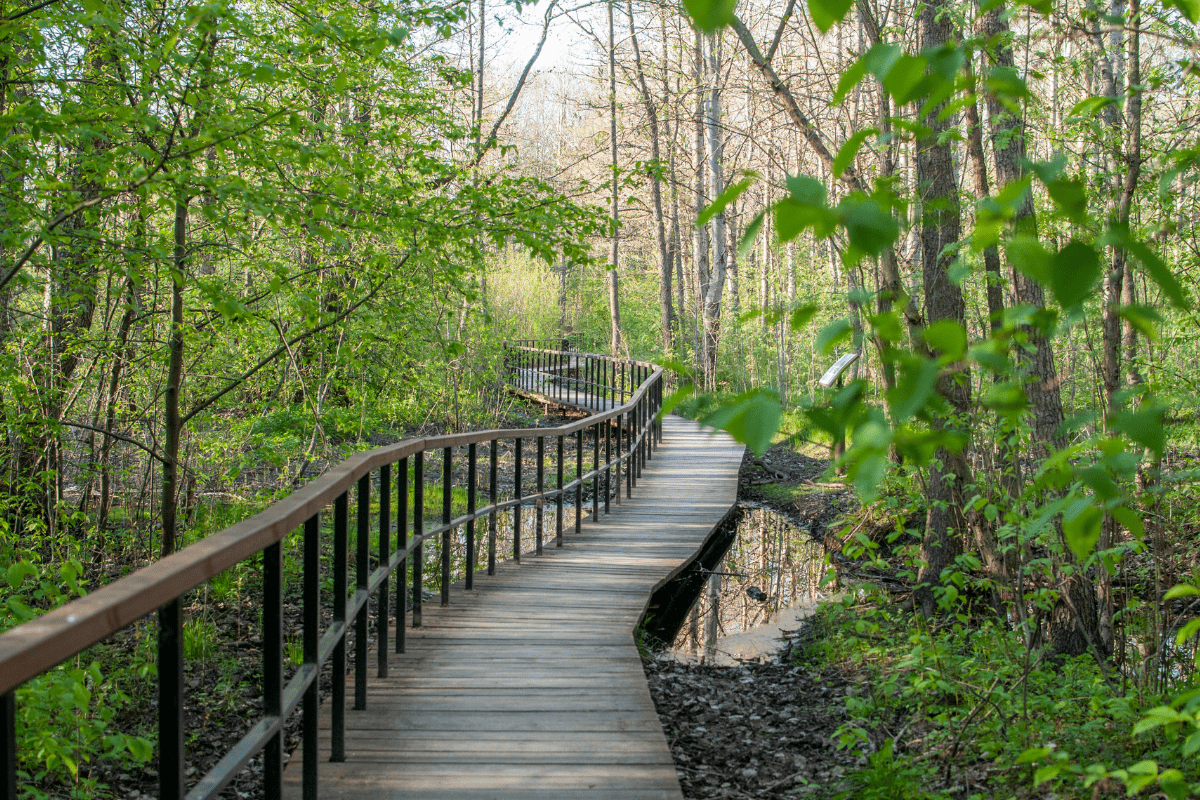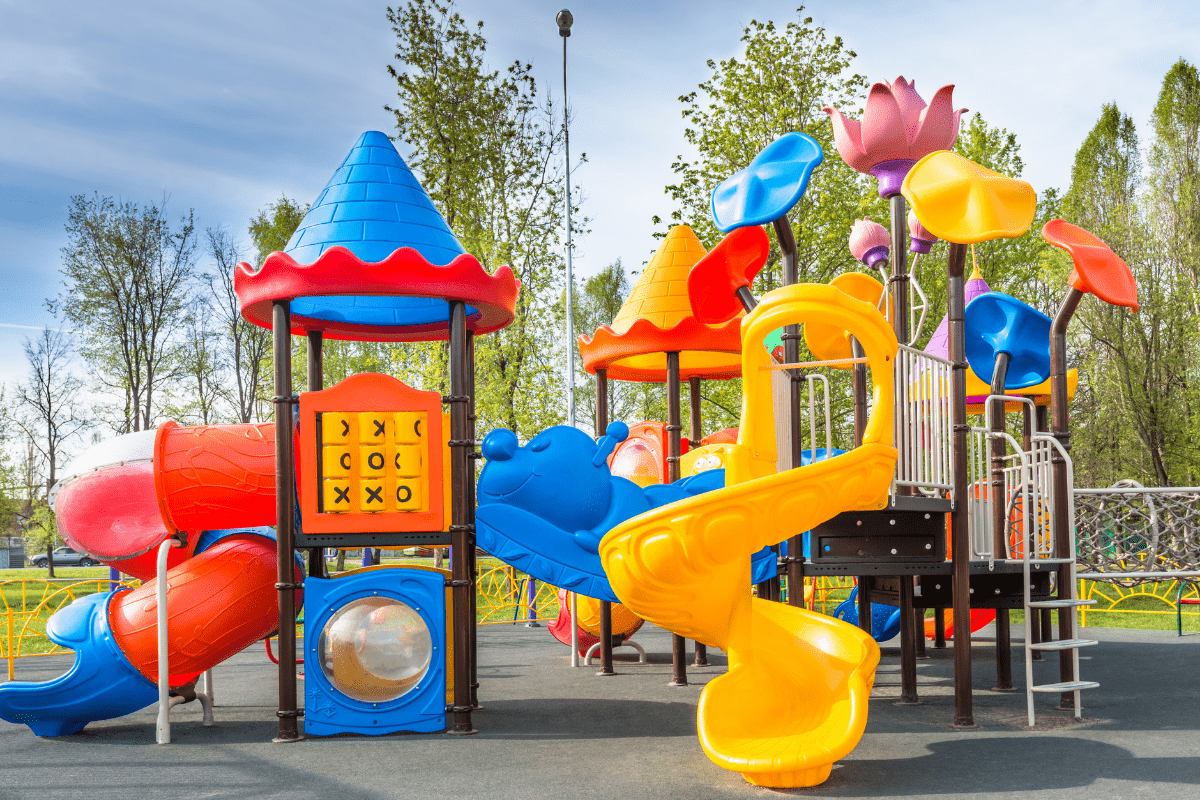Traverse City stands at the crossroads of rolling forests, sparkling lakes, and some of the most accessible hiking trails in the region. Whether you crave peaceful boardwalk strolls, woodland adventures with your pup, or breathtaking views just minutes from downtown, there is a path here for every mood and season.
Let’s get to it.
Boardman Valley Nature Preserve
At Boardman Valley Nature Preserve, you can follow about 1.5 miles of flat trails along the Boardman-Ottaway River, winding through wildflower meadows and ancient cedar groves. Wooden boardwalks and bridges connect the paths, keeping wet spots and roots to a minimum. A short hill near the Nature Center adds a bit of challenge if you want to switch to the upper trail.
Small observation decks host weekend anglers, and a picnic pavilion offers a spot for families to gather. You can launch a regular or ADA-accessible kayak from designated sites. A vault restroom sits near the main parking area and stays surprisingly clean. Leashed dogs are welcome, and you will often see them darting through the underbrush. Most of the paths remain easy underfoot unless you take the steeper incline near the Nature Center.
In winter, cross-country skiers glide along the groomed tracks, while spring brings fresh signs of beaver dams and frog calls. Signage is clear along every branch in the trail network, so you can explore with confidence without ever feeling truly lost.
Miller Creek Nature Reserve
At Miller Creek Nature Reserve, a network of easy-to-moderate trails offers about 3.2 miles on the main loop and up to 5 miles including side paths. The trail surface alternates between packed dirt, gravel, and sections of boardwalk. Creek crossings require a short rock hop.
Vegetation ranges from red pines and hardwoods to wetland areas populated by frogs and waterfowl. Open meadows add variety, and turtles often sun themselves on logs near the water. Benches are available at intervals, but restrooms and drinking stations are absent, so bring water and a bathroom plan.
Leashed dogs are welcome and enjoy access to creek edges. Trailheads provide a small parking area with space for several vehicles. Crowds remain light even on weekends, giving a quiet hike through the woods. The reserve does not have paved or wheelchair-accessible paths. Trail markers are clear at major intersections, though some smaller spurs may be confusing without a map. Overall, the reserve delivers a straightforward woodland experience close to town.
Traverse Area Recreation Trail (TART)
Walking or cycling the Traverse Area Recreation Trail, often called TART, connects many of Traverse City’s top outdoor spots. The paved path spans 10.5 miles from downtown to Acme Township. Trail users can extend their route via the Acme Connector, the Leelanau Trail, or the Boardman Lake Loop for extra mileage. The surface is smooth asphalt or concrete, and gradients rarely exceed typical driveway slopes. Wheelchairs and strollers can navigate the trail without difficulty.
As users pass Clinch Park Marina, they see kayaks gliding on Grand Traverse Bay. Farther along, Reffitt Nature Preserve offers a shady forested stretch. Vineyards and farmland fill the rural sections with scenic views. Benches and picnic tables appear at regular intervals, and restrooms as well as drinking fountains are conveniently located. Leashed dogs are welcome, and pet waste stations help maintain cleanliness. Weekend crowds tend to thicken near downtown and the waterfront, but traffic thins out in country sections. Trail maintenance remains consistent year-round, and winter snow removal keeps the main corridor accessible for walkers, runners, and cyclists alike.
DeYoung Natural Area
DeYoung Natural Area blends a pair of loop trails that remain accessible to nearly everyone. The Pier and Cedar Forest Loop covers 0.8 miles of packed dirt and boardwalk winding around swamp edges. The longer Cedar Forest, Wild Edibles, Forest Valley and Farmstead Loop spans 2.1 miles, climbing just over 100 feet to pass an old orchard and a historic barn.
Parking includes graveled ADA stalls and a vault toilet nearby. Hand-pump water sits near the main trailhead and benches dot the path for rest stops. A fishing pier overlooks Cedar Lake, making it easy to spot ducks or watch a line bob.
Leashed dogs are welcome and usually outnumber other hikers on weekdays. In summer, look for wild berries or grapes in the undergrowth. Visitors can enjoy accessible pathways through meadows and cedar groves without heavy crowds.
The area remains open year-round, with groomed tracks for skiing or snowshoeing once the first snow falls. Trail maintenance is consistent, and staff check boardwalks and signs regularly to keep everything in top condition.
Leelanau Trail Cherry Bend Rd Trailhead
At the Cherry Bend Road Trailhead, Leelanau Trail begins with a smooth, paved path suited to cyclists, wheelchair users and families with strollers. The parking lot holds about a dozen cars, so weekends can fill up quickly in summer or during peak fall color days. Dogs in bandanas are common companions as long as they stay leashed.
Once on the trail, hardwood forests give way to vineyard views and gentle creek crossings. Benches and picnic tables are placed at regular intervals, inviting riders or walkers to pause. The grades remain so mild that most people never break a sweat unless they plan a longer ride deeper into the peninsula.
In winter, crews groom the lower section for cross-country skiing and fat-tire biking. Trail surfaces stay well maintained, but a heavy rain can leave the gravel damp for a day. Wildlife sightings include deer grazing at dawn and turtles sunning themselves at wetland edges. Overall, this trailhead delivers an easy, lowkey start to the broader Leelanau network, offering clear mileage markers and a quiet launch point for nearly any outdoor activity.
Grand Traverse Natural Education Reserve
The Grand Traverse Natural Education Reserve stretches along the Boardman River with about seven miles of trails weaving through forests, marshes and wetlands. Most paths have under 120 feet of elevation gain, so hikers rarely need poles or special gear. The surface changes from dirt and gravel to boardwalks and wooden bridges spanning low areas.
Lone Pine Trail offers barrier-free paved sections for wheelchairs and strollers. Trailheads provide free parking, vault restrooms and an exhibit gallery at the Boardman River Nature Center. Benches and picnic tables appear along the route for short breaks or wildlife spotting. Platforms near wetlands let you stand quietly to watch beavers at work or listen for songbirds.
Hikers keep dogs leashed and usually find plenty of space since crowds stay small away from trailheads. Maintenance crews check signage and repair stairs as needed, though spring can bring muddy sections that require boots. The reserve stays open year-round, offering snow-covered trails for cross-country skiing and snowshoeing. Overall, upkeep is solid and clear, providing a reliable network for both casual strolls and deeper nature exploration.
Boardman Lake Trail
Circling Boardman Lake, this four-mile loop blends paved sections with gravel, crushed limestone and boardwalk over the water. Lookout piers and fishing decks appear at regular intervals, along with public art installations and wetlands ideal for birdwatching. Railings on the boardwalk and wider paths make most of the route accessible to strollers and wheelchairs.
A steeper section along the eastern shore may require extra effort for wheelchair users or anyone pushing a stroller. Benches and picnic tables are spaced evenly, giving you a chance to rest. Kayak launches and a small library branch connect to the trail, adding to the appeal.
In summer, the trail becomes busier with families, runners and leashed dogs enjoying the lakeside views. Maintenance crews smooth the pavement and check signage so you rarely encounter obstacles. In winter, the path turns into a groomed course for cross-country skiing and snowshoeing. Watch for icy spots on the boardwalk after a storm since those areas can freeze over quickly.
This loop rarely feels crowded except on peak weekend afternoons when local dog owners and cyclists converge for fresh air.
Pelizzari Natural Area
Pelizzari Natural Area offers a 2.2 to 2.8-mile main loop over packed earth and dirt. Trail markers appear at each junction, and an information kiosk sits at the trailhead by Old Mission Peninsula’s M-37. Parking is plentiful and easy to access.
The route wanders through open fields, abandoned orchards, hardwood stands, and dense hemlock woods. A few benches provide rest with intermittent views of East Grand Traverse Bay. Elevation gain reaches about 200 feet in total, creating gentle climbs rather than steep challenges.
Restrooms and paved paths are not available, though dog walking remains popular on a leash. The area opens daily until 10 p.m., and winter visitors often bring snowshoes or skis when conditions allow. This natural area focuses on simplicity: clear trails, varied vegetation, and quiet surroundings. It serves walkers, families, and casual hikers seeking a low-impact outdoor experience without demanding terrain or extensive facilities.
Grand Traverse Commons Natural Area
Grand Traverse Commons Natural Area features more than 50 miles of unpaved trails through woodlands, meadows, and rolling hills. Popular routes include the Meadow Loop and Copper Ridge Trail, which offer wide views of the surrounding landscape. The Garfield and Old Orchard Loop weaves through gentler terrain, making it ideal for families.
Buffalo Ridge Trail climbs to a low hilltop with well-maintained footing. Trailheads provide parking, benches, and picnic tables, but there are no restroom facilities within the natural area. Leashed dogs are welcome, though off-leash activity is prohibited. Wheelchairs and strollers are not recommended on these surfaces.
Signage appears at most intersections, but hikers should carry a map to avoid confusion on intersecting routes. Spring and fall weekends bring moderate visitor numbers, while weekdays are typically quieter. The trails are open year-round. During winter, minimal maintenance leaves snow and ice on the paths after heavy storms. Overall, the natural area offers extensive hiking just outside the city, with varied terrain and scenic outlooks for day trips on clear-footed trails.
Hickory Meadows
Located just west of Traverse City, Hickory Meadows offers 112.5 acres of untamed nature. Open fields of wildflowers spread across gentle slopes, while forested hideouts provide shaded retreats. The main loop covers 2.1 miles with only 180 feet of climbing, a distance most hikers find approachable. Dirt paths wind through grass and woods, skirting small ponds and trickling creeks. You might spot butterflies flitting among blooms or see a happy lab pause for a drink.
The preserve has no paved paths, restrooms, or water stations, so bring your own supplies. Free parking and info boards at the trailhead supply basic maps and guidelines. Leashed dogs are welcome, and many locals treat it as an unofficial dog park. Despite regular visits, the trails rarely feel crowded except on clear winter Saturdays after fresh snow. Seasonal changes keep the scenery fresh: spring blossoms, summer greens, autumn grasses, and a quiet snowy landscape. Trail maintenance keeps the route clear year-round, although muddy patches can appear after rain. Overall, this low-key space delivers well-maintained trails and a simple, year-round escape.
Hull Park
Hull Park provides a 4.2-mile loop around Boardman Lake with paved walkways, wood boardwalks, and smooth gravel. The entire circuit meets ADA standards, accommodating wheelchairs, strollers, and leashed dogs. Parking and seasonal restrooms are available near the trailhead.
The park links directly to the TART Trail, allowing visitors to extend their route. Along the shoreline, fishing decks and piers offer lake access. Bridge crossings over the Boardman River connect different sections of the loop. Picnic tables and benches appear at intervals beside the water, and a boat launch serves kayaks and small motorboats.
Summer weekends bring higher visitor numbers, but the trail generally feels spacious. The park remains open year-round; snow removal is limited in winter. Public signage marks the route clearly, and distance markers help track progress. Hull Park stands out for its reliable maintenance, accessible design, and scenic lakeside setting, making it a consistent choice for casual walks, family outings, and light outdoor recreation near Traverse City.





